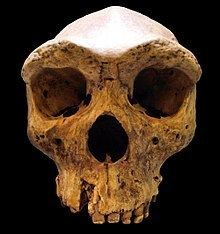Scientific name Homo rhodesiensis Rank Species | Phylum Chordata Genus Homo Higher classification Humans | |
 | ||
Similar Humans, Homo cepranensis, Homo heidelbergensis, Great apes, Homo rudolfensis | ||
Homo rhodesiensis modeled from a man and a chimpanzee
Homo rhodesiensis refers to an extinct hominin species of the genus Homo, first described in 1921 by Arthur Smith Woodward in reference to the Kabwe skull fossil recovered at Broken Hill, or Kabwe, in Zambia (once known as Northern Rhodesia). A number of morphologically-comparable fossil remains came to light in East Africa (Bodo, Ndutu, Eyasi, Ileret) and North Africa (Salé, Rabat, Dar-es-Soltane, Djbel Irhoud, Sidi Aberrahaman, Tighenif) during the 20th century and were classified as Homo rhodesiensis.
Contents
- Homo rhodesiensis modeled from a man and a chimpanzee
- Discovery
- Bodo Cranium
- Ndutu cranium
- Classification
- Present location
- Literature
- References
Smith Woodward decided the fossils represented an extinct hominid species as the "... thick skull, sloped forehead and giant brow ridges made the species distinct from living people". The finds were dated between 300,000 and 125,000 years BC. "However, this [African] group of fossils has [also] been known by many other now-obscure names", none ever having been accepted universally, including the taxon Homo rhodesiensis. The Saldanha cranium, found in 1954 in South Africa was subject to at least three taxonomic revisions from 1955 to 1996. Consensus is confined to informal taxonomic categories, such as "pre-modern".
Most scientists now regard Homo rhodesiensis as to be the local (African) representative of Homo heidelbergensis and as such the direct ancestor of anatomically modern humans.
Discovery
Kabwe 1, also called the Broken Hill skull, was assigned by Arthur Smith Woodward in 1921 as the type specimen for Homo rhodesiensis; most contemporary scientists forego the taxon "rhodesiensis" altogether and assign it to Homo heidelbergensis. The cranium was found in a lead and zinc mine in Broken Hill, Northern Rhodesia (now Kabwe, Zambia) in 1921 by Tom Zwiglaar, a Swiss miner. In addition to the cranium, an upper jaw from another individual, a sacrum, a tibia, and two femur fragments were also found. The skull was dubbed "Rhodesian Man" at the time of the find, but is now commonly referred to as the Broken Hill skull or the Kabwe cranium.
The association between the bones is unclear, but the tibia and femur fossils are usually associated with the skull. Rhodesian Man is dated to be between 125,000 and 300,000 years old. Cranial capacity of the Broken Hill skull has been estimated at 1,230 cm³. Bada, & al., (1974) published the direct date of 110 ka for this specimen measured by aspartic acid racemisation. The destruction of the paleoanthropological site has made layered dating impossible.
The massive skull suggests an extremely robust individual with the comparatively largest brow-ridges of any known hominid. It was described as having a broad face similar to that of Homo neanderthalensis (i.e. large nose and thick protruding brow ridges). Consequently, researchers came up with interpretations such as "African Neanderthal". However, with regard to the skull's extreme robustness, recent research has highlighted several intermediate features between modern Homo sapiens and Neanderthal.
Bodo Cranium
The 600.000 year old Bodo cranium was found in 1976 by members of an expedition led by Jon Kalb at Bodo D'ar in the Awash River valley of Ethiopia. Although the skull is most similar to those of Kabwe, Woodward's nomenclature was discontinued and its discoverers attributed it to H. heidelbergensis. It has features, that represent a transition between Homo ergaster/erectus and Homo sapiens.
Ndutu cranium
Another specimen, "the hominid from Lake Ndutu" in northern Tanzania, around 400,000 years old. In 1976 R.J.Clarke classified it as Homo erectus and it has generally been viewed as such since, although points of similarity to H. sapiens have also been recognized. After comparative studies with similar finds in Africa allocation to an African subspecies of H. sapiens seems most appropriate. An indirect cranial capacity estimate suggests 1100 ml. Its supratoral sulcus morphology and the presence of protuberance as suggested by Philip Rightmire "give the Nudutu occiput an appearance which is also unlike that of Homo erectus", but Stinger (1986) pointed out that a thickened iliac pillar is typical for Homo erectus. In a 1989 publication Clarke concludes: "It is assigned to archaic Homo sapiens on the basis of its expanded parietal and occipital regions of the brain".
Classification
In Africa, there is a distinct difference in the Acheulean tools made before and after 600,000 years ago with the older group being thicker and less symmetric and the younger being more extensively trimmed.
Rupert Murrill has studied the relations between the Archanthropus skull of Petralona (Chalcidice, Greece) and Rhodesian Man. Most current experts believe Rhodesian Man to be within the group of Homo heidelbergensis though other designations such as Homo sapiens arcaicus and Homo sapiens rhodesiensis have also been proposed.
According to Tim White, it is probable that Rhodesian Man was the ancestor of Homo sapiens idaltu (Herto Man), which itself was the ancestor of Homo sapiens sapiens. The skull has cavities in ten of the upper teeth and is considered one of the oldest known occurrences of cavities. Pitting indicates significant infection before death and implies that the cause of death may have been due to dental disease infection or possibly chronic ear infection.
Present location
The Broken Hill skull is one of the treasures in the collections cared for by the Natural History Museum, London. There is a replica in the Museum in Livingstone, Zambia.
